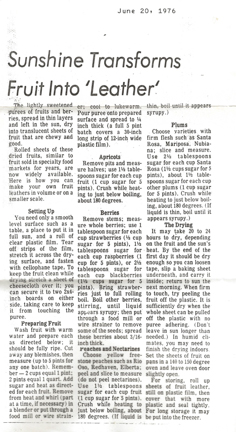Sunshine Transforms Fruit Into ‘Leather’
Description
The lightly sweetened purees of fruits and berries, spread in thin layers and left in the sun, dry into translucent sheets of fruit that are chewy and good. Rolled sheets of these dried fruits, similar to fruit sold in specialty food markets for years, are now widely available. Here is how you can make your own fruit leathers in volume or on a smaller scale.Setting Up
You need only a smooth level surface such as a table, a place to put it in full sun, and a roll of clear plastic film. Tear off strips of the film, stretch it across the drying surface, and fasten with cellophane tape. To keep the fruit clean while drying stretch of sheet of cheesecloth over it; you can secure it to two 2x4-inch boards on either side, taking care to keep it from touching the puree.
Preparing Fruit
Wash fruit with warm water and prepare each as directed below; it should be fully ripe. Cut away any blemishes, then measure (up to 5 pints for any one batch). Remember – 2 cups equal 1 pint; 2 pints equal 1 quart. Add sugar and heat as directed for each fruit. Remove from heat and whirl (part at a time, if necessary) in a blender or put through a food mill or wire strainer; cool to lukewarm. Pour puree onto prepared surface and spread to ¼ inch thick (a full 5 pint batch covers a 30-inch long strip of 12-inch wide plastic film).
Apricots
Remove pits and measure halves; use 1 ½ tablespoons sugar for each cup fruit (1 cup sugar for 5 pints). Crush while heating to just below boiling, about 180 degrees.
Berries
Remove stems; measure whole berries; use 1 tablespoon sugar for each cup strawberries (1/2 cup sugar for 5 pints), 2 ½ tablespoons sugar for each cup blackberries (1 1/2 cup sugar for 5 pints). Bring strawberries just to full rolling boil. Boil other berries, stirring, until liquid appears syrupy; then put through a food mill or wire strainer to remove some of the seeds; spread these berries about 3/16-inch thick.
Peaches and Nectarines
Choose yellow freestone peaches such as Rio Oso, Redhaven, Elberta; peel and slice to measure (do not peel nectarines). Use 1 ½ tablespoons sugar for each cup fruit (1 cup sugar for 5 pints). Crush while heating to just below boiling about 189 degrees. (If liquid is thin, boil until it appears syrupy.)
Plums
Choose varieties with firm flesh such as Santa Rosa, Mariposa, Nubiana; slice and measure. Use 2 ½ tablespoons sugar for each cup Santa Rosa (1 ½ cups sugar for 5 pints), about ½ tablespoons sugar for each cup other plums (1 cup sugar for 5 pints). Crush while heating to just below boiling, about 180 degrees. (If liquid is thin, boil until it appears syrupy.)
The Drying
It may take 20 to 24 hours to dry, depending on the fruit and the sun’s heat. By the end of the first day it should be dry enough so you can loosen tape, slip a baking sheet underneath and carry it inside; return to sun the next morning. When firm to touch, try peeling the fruit off the plastic. It is sufficiently dry when the whole sheet can be pulled off the plastic with no puree adhering. (Don’t leave in sun longer than needed.) In humid climates, you may need to finish the drying indoors. Set the sheets of fruit leather, still of plastic and seal tightly. For long storage it may be put into the freezer.
Creator
Contributor
Meal Type
Cuisine
Name Index
Collection
Citation
Mary Simonian, “Sunshine Transforms Fruit Into ‘Leather’,” Armenians of Whitinsville, accessed June 7, 2025, https://armeniansofwhitinsville.org/items/show/1837.


Comments